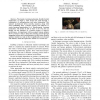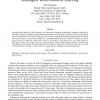3084 search results - page 116 / 617 » Learning to Take Actions |
HRI
2006
ACM
15 years 4 months ago
2006
ACM
Programming robots to carry out useful tasks is both a complex and non-trivial exercise. A simple and intuitive method to allow humans to train and shape robot behaviour is clearl...
ATAL
2003
Springer
15 years 3 months ago
2003
Springer
A collective of agents often needs to maximize a “world utility” function which rates the performance of an entire system, while subject to communication restrictions among th...
ICRA
2008
IEEE
15 years 4 months ago
2008
IEEE
— We present a learning mechanism, Socially Guided Exploration, in which a robot learns new tasks through a combination of self-exploration and social interaction. The system’s...
100
click to vote
IAT
2003
IEEE
15 years 3 months ago
2003
IEEE
A gradient-based method for both symmetric and asymmetric multiagent reinforcement learning is introduced in this paper. Symmetric multiagent reinforcement learning addresses the ...
ICMLA
2008
14 years 11 months ago
2008
Learning by imitation has shown to be a powerful paradigm for automated learning in autonomous robots. This paper presents a general framework of learning by imitation for stochas...


